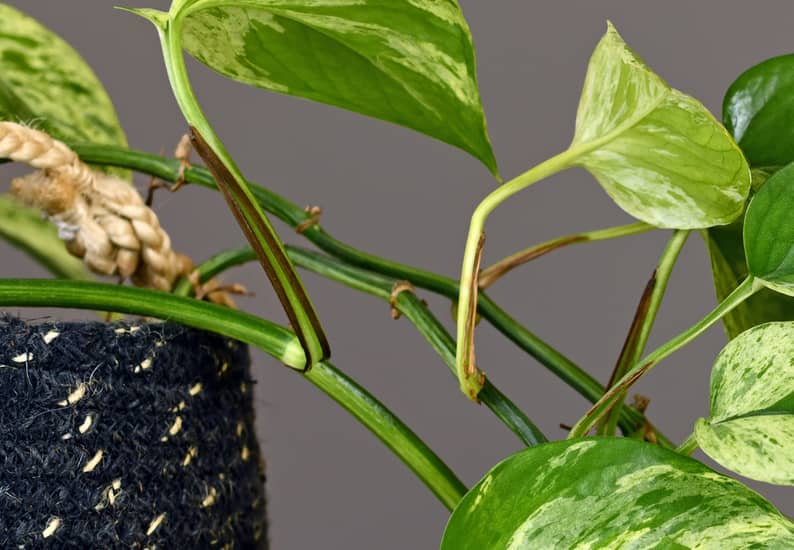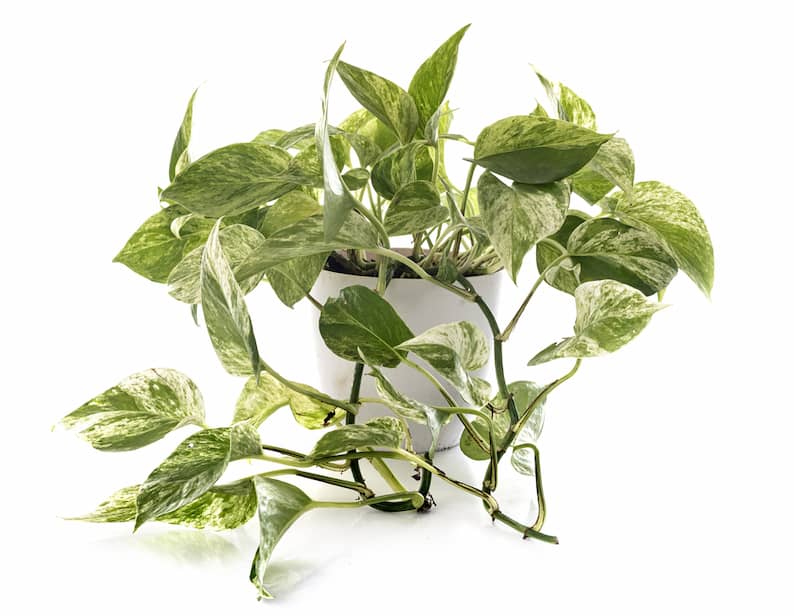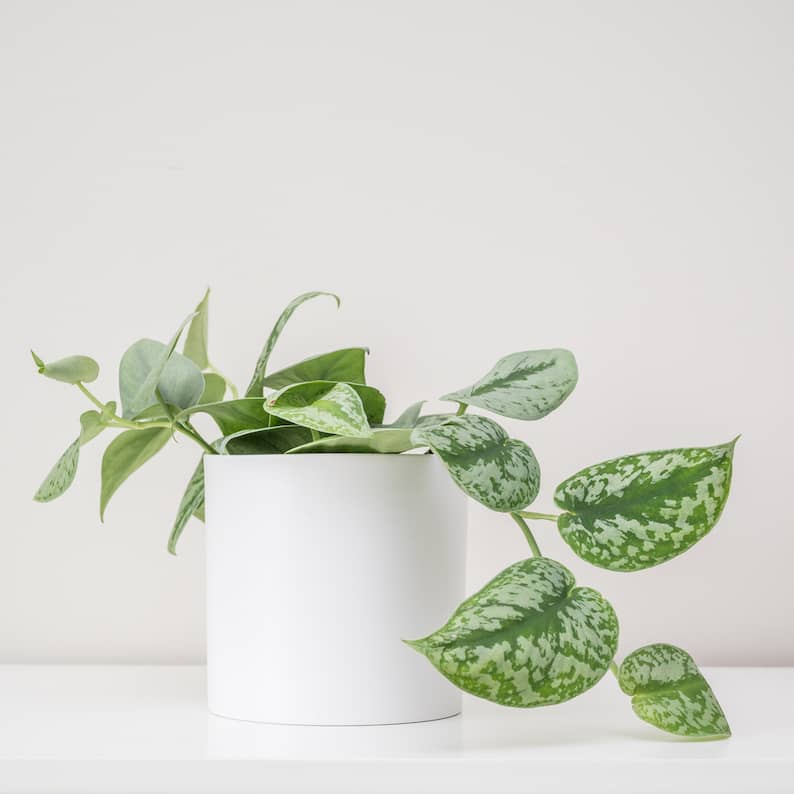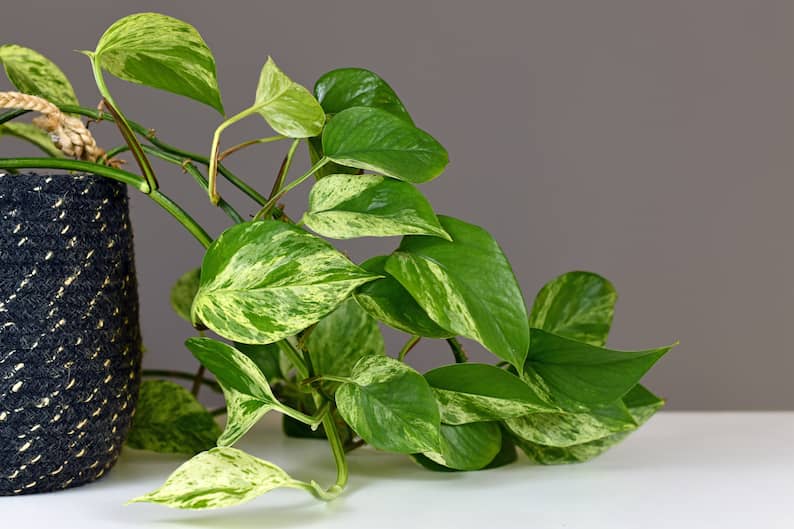Pothos (Epipremnum aureum) has remained a favorite among houseplant varieties for the longest time. Many plant novices prefer pothos because they are easy to take care of and highly versatile. However, if you notice your pothos having brown stems where it didn’t before, this may be a sign of a problem.
Pothos stems can begin to turn brown due to improper environmental conditions. The unacceptable conditions include high humidity, exposure to direct sunlight, and improperly drained soil. Such unfriendly conditions cause improper circulation in the plant, and hence it develops decaying growth.
Although pothos are considered low maintenance plants, they become distressed and eventually die quickly under very minimal care. This article will educate you more on possible causes of distress to your stunning, evergreen pothos plant.

Table of Contents
Why are my pothos stems turning brown?
Browning of the pothos’ stems occurs due to improper and extreme environmental conditions.
You may notice your pothos’ stems turning brown with time. The following are environmental conditions that result in the browning of the pothos stems.
1. Improper watering routine
Watering your pothos is an essential activity that you should carry out cautiously. Overwatering lowers circulation in the plant because excess water in the soil prevents the roots from receiving oxygen. Inadequacy of oxygen leads to your pothos roots rotting.
Find out the signs that you may have an overwatered pothos – as well as how to fix it ASAP.
When the roots of the pothos decay, the plant cannot receive the crucial nutrients and minerals that it requires for its growth. In turn, it causes your pothos to have brown stems. Alternatively, underwatering a pothos results in stem browning as well.
2. Exposure to direct sunlight
As much as your Pothos can tolerate a wide range of light conditions, exposure to direct sunlight affects its growth. Direct sunlight causes excessive variegation, which makes the plant dry out. This condition subjects your Pothos to dark brown stems.
Pothos requires bright indirect light to do well. Although this plant can also do well under low light, it is crucial to regulate lighting. This way, your plant will not struggle due to improper light conditions.
Find out all about: What Are Your Pothos’ Light Needs?
3. Extreme temperatures
Pothos thrives in relatively high temperatures. High humidity levels are great for pothos, so they will thrive if you happen to live somewhere with a tropical climate.
However, extreme temperatures are not suitable for the plant and lead to the browning of the stems. It would help if you placed your pothos at a temperature of 500F, with an optimal range of 60 to 800F. This way, you will prevent your pothos stems from drying.

4. Presence of excess fertilizers in the soil
You may opt to incorporate fertilizer to enhance the growth of your Pothos. However, using too much fertilizer while growing your pothos leads to excessive nutrient deposition in the soil.
These nutrients become harmful to the roots and cause them to decay. The damage that follows is pothos stems rotting.
Best fertilizer for Pothos
Jack’s Classic 20-20-20 All Purpose Fertilizer
A great fertilizer with the perfect balance for your pothos. Simply dissolve in water and feed your plant to watch it thrive.
5. Nature of soil
All types of pothos thrive in well-draining soils. Planting pothos in improperly drained soils generates browning of the stems.
Also, pothos flourishes in slightly acidic soils from PH 6.1 to PH 6.5. Soils with very high or deficient acidic levels lead to pothos having brown stems.
How to fix brown stems on pothos
Thankfully, there are corrective measures that you can put in place to fix brown stems on your pothos. Immediately, your plant shows this unhealthy sign; you can improvise the following remedial measures.
1. Provide indirect sunlight
Since excessive sunlight makes pothos have brown stems (it can also lead to brown spots on your pothos’ leaves), ensure that you place your plant where it accesses an adequate amount of light. The appropriate amount of light will prevent further browning of the stems.
You can add a sheer curtain to regulate the amount of light entering the room. Alternatively, you can move the plant to a spot that receives minimal light. This way, the plant will be safe from further stem browning.
2. Flush out excess fertilizers
Excessive build-up of nutrients damages pothos. To fix a pothos woody stem resulting from excess fertilizers, you can run water through the soil. Water acts by flushing out the surplus salts and reducing the stems’ browning.
You can carry out the flushing process by making holes at the bottom of your planter. Then run the water and let it drain from the bottom of the planter. Repeat the process to flush out excess nutrients from the soil.

3. Maintain the right temperature
It would be best to consider growing your pothos in a room with an optimum temperature range of 70F to 80F. Within this temperature, your pothos will thrive because they do well under different growing conditions.
The stem will slowly regain its health and cease browning at the correct temperatures.
4. Correct your watering routine
Improper watering habits are the prominent cause of stem browning, especially for the Marble Queen pothos variety. As a plant enthusiast, note that pothos do not require too much water, especially indoors.
When you subject your pothos to saturated, dense soils for prolonged periods, you may notice your pothos developing brown stems due to possible root rot. If you leave the condition unattended, your plant will suffer and later on dry out.
Allow the planter to dry out before you can water your pothos again. Please reconsider your watering pattern to fix a pothos with brown stems.
5. Transplant the pothos
To fix the brown stem of your pothos, you can opt to initially repot the plant. Repotting works well to prevent further browning of stems, especially in soggy soil.
Let it lay openly overnight once you remove your pothos from the previous planter. Next, transplant the pothos into the new soil, which should be well-drained.
Repotting the pothos plant will fix issues that were causing stem browning in the previous planter.
Best soil for Pothos
Miracle-Gro Tropical Potting Mix
Light and well-draining (perfect for avoiding root rot) while being packed with just the right nutrients – that will feed your plant for up to six months. The best soil for keeping your pothos healthy and strong.
Are pothos’ stems supposed to be brown?
Initially, pothos stems are not supposed to be brown but relatively of the same color as the leaves. Brown stems indicate unhealthy growing conditions that result in the drying of the plant. It may occur due to root rot resulting from bacterial and fungal infections.
It is easy to identify a pothos’ stem rotting because you will notice the stem turning brown. The stem will also feel drier to touch, a condition known as pothos woody stem. Once you see this condition, you should focus on fixing the brown stem on your plant.

Pothos plants are not picky about premium growing conditions. But, when prone to diseases, this plant undergoes stem browning. Below are illnesses that can lead to stem browning.
- Fungal infections: Rot is one of the most common fungal infections affecting pothos. Rot affects the root system of pothos and damages the roots immensely. Root rot then causes pothos to have brown stems. To treat fungal infections in pothos, use fungicides as they work effectively.
- Bacterial infections: Similarly, bacterial infections put the health of pothos at risk. Bacterial infections damage the roots and therefore lead to pothos stem rotting. You can regulate the threat of bacterial infections using insecticidal soap.
- Blight: Blight usually attacks pothos due to unsustainable environmental conditions. The conditions include high humidity, which results in poor air circulation within the plant. Blight finally affects pothos to the point of causing brown stems.
Should you cut off your pothos’ brown stems?
Whether you cut off your pothos brown stem depends on the intensity of the damage. You may first want to try improving your plant’s conditions to improve its survival chances before pruning. Carrying out a diagnosis and treating the entire plant is also an option to consider.
Leaving the damaged stems without taking any corrective measures will make your entire plant dry off. This is why one option you may want to consider is that you can cut off the stem and place your cuttings in water to generate roots sprouting.
That said, if your plant has extreme damage, you can cut off the stem following this procedure.
- Untangle the stems. Pothos has many stems that usually tangle together. Untangling the stems will guide you to know which stem and where to cut it.
- Choose where to cut. You should cut at the node. It’s where hormones have a high concentration and will likely sprout new roots.
- Cut off the damaged part of the stem. You can use scissors or pruning shears to prune your pothos. Ensure your cuttings are at least five inches long. Longer stems will offer many spots for roots to sprout.
- Remove excess leaves. You should remove all the leaves below the waterline of your rooting jar. They rot if you immerse them in the water. Do it carefully so as not to wound the stem.
- Cut off long stems at the tip. The top end of the pothos cutting should not have extensions. The extensions will eventually die back and look unattractive. Clean cuttings will allow the stem to heal quickly.
- Place the stems in water. Place the stems in an air-tight container. You can consider using a glass container to monitor the root growth easily. Tap water will give you better results.
- Grow the pothos plant. Once your cuttings develop roots, plant them in a suitable pot. Water the plant and give it the necessary care.
What are the brown bumps on my pothos’ stems?
Pest infestations are among the most common causes of brown bumps on the stems of pothos plants. Pests suck out sap on pothos’ branches, which leaves brown bumps. Common pests that attack pothos include mealybugs, spider mites, aphids, and scales.
Harmful sap-sucking insects deprive the pothos plant of its nutrients and water. These pests target the plant and suck juices out of it.
Some pests go as far as injecting toxins into the stems of the pothos plant. The injected toxins appear as moving dots or bumps. These toxins mishap and distort the stems.
Here are a few damage-causing plants you should look out for in your pothos plant.
- Mites: Mites look more like spiders than insects. It is hard to spot mites because they hide between the stem and leaves. Mites can wreck the stem because they leave spots of damage behind.
- Mealybugs: Mealybugs are tiny white insects, and they love a humid environment. They feed on the sap present in the pothos stem. They cause browning and pothos woody stem.
- Scale: This is among the most destructive pests. You are more likely to find it on the pothos stems. They damage the crucial transport system of the plant since they leave honeydew behind once they suck. The honeydew left by scales results in sooty mold on the plant’s stem.
- Aphids: Aphids are tiny bugs that are difficult to spot. Once they are in groups, you can quickly identify them. If a colony of aphids sucks the stem of photos, they will overwhelm the plant leaving it for dead. Aphids leave behind brown lumps on the pothos’ stem.
A pothos plant with brown bumps from pest infestations stands a higher chance of dying if not attended to. Pests spread diseases that need immediate treatment
The best methods to keep pests from your Pothos are:
- Use bug spray: You should spray bug spray on the pest-infested pothos plant.
- Rub alcohol: Alcohol is an excellent option to keep pests away.
- Use soap and water: Cover your pothos plant with soap and water. This technique will prevent bugs from sticking to the stem surface.


